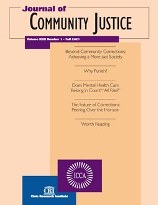Complete Issue
Author: Don Evans.; Michael Gilbert.
Source: Volume 18, Number 02, Winter 2009 , pp.1-24(24)

< previous article |return to table of contents
Abstract:
This issue is the second of two issues focused on restorative justice issues developed from papers presented at the 1st National Conference on Restorative Justice (2007). The theme of this issue is Restorative Justice Through Different Lenses. Each of the essays examines restorative justice from a different cultural perspective—that of Canada, India, and Chile. Each, in its own way, provides important insights into the possibilities of, and challenges to, the expanded application of restorative justice. Each article asks the reader to consider how principles of restorative justice can be used to respond to criminal or problem behaviors? Unfortunately, the initial reaction of many practitioners is not on the possibilities restorative justice presents but on the reasons why they cannot apply restorative justice in their jurisdiction. In Canadian Research on Restorative Justice in Criminal Matters: An Update, Dr. Tanya Rugge has written an important review of recent research on restorative programs and practices in Canada. She is a researcher with the Corrections Research Unit of Public Safety Canada, which is a federal agency responsible for funding and evaluating pilot programs related to public safety. Her paper summarizes quasi-experimental evaluation studies and meta-analyses conducted by the Corrections Research Unit. The quality of the research produced by the Corrections Research Unit is among the most rigorous and well-designed research available. The Unit’s research on restorative justice has begun to address the paucity of social science evaluation of restorative justice programs, practices, and principles. The mounting research evidence in Canada and around the world is that restorative justice can offer effective and meaningful responses to offending behavior. In 2002, the United Nations provided guidelines for the application of restorative justice in criminal cases. In total, the evidence suggests that broader application of restorative justice principles and programs may be warranted. Yet, there are still challenges related to program development, funding, and political and social climate that confront the expansion of restorative practices. Practitioners will find this overview helpful in program design, development, implementation, and evaluation of restorative justice processes. In The Applicability of Restorative Justice Practices to Domestic Violence in India, Ms. Sayantini Guin courageously explores the potential and limitations of restorative justice theory, principles, and practices with the deeply rooted cultural problem of domestic violence against women in the male-dominated culture of India. She highlights the crucial role of cultural competence in any application of restorative justice in domestic violence cases. She also explores the limits of restorative justice in the context of existing Indian law and the history of violent gender relations within families. Ms. Guin’s exploration of restorative justice as a response to such a deeply embedded social problem within Indian culture encourages the reader to be equally courageous in envisioning the potential of restorative justice.Keywords:
Affiliations:
.